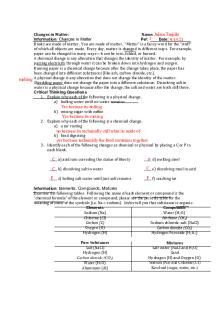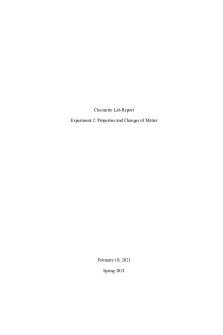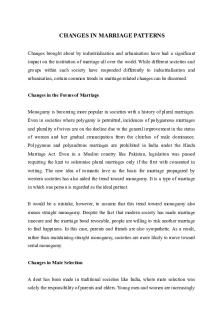Changes in Matter PDF

| Title | Changes in Matter |
|---|---|
| Author | sfsfdsfsd fsdfdsfsd |
| Course | General Chemistry I |
| Institution | Sacramento City College |
| Pages | 4 |
| File Size | 343.2 KB |
| File Type | |
| Total Downloads | 69 |
| Total Views | 166 |
Summary
Changes in matter worksheet...
Description
Changes(in(Matter:( ( ( ( ( ( Name:(Julian ( ( ( ( Trujillo Information: Changes in Matter Per: 3 Date: 9/14/21 Books%are%made%of%matter.%%You%are%made%of%matter.%%“Matter”%is%a%fancy%word%for%the%“stuff”% of%which%all%objects%are%made.%%Every%day,%matter%is%changed%in%different%ways.%%For%example,% paper%can%be%changed%in%many%ways—it%can%be%torn,%folded,%or%burned.%%% A%chemical%change%is%any%alteration%that%changes%the%identity%of%matter.%%For%example,%by% passing%electricity%through%water%it%can%be%broken%down%into%hydrogen%and%oxygen.%% Burning%paper%is%a%chemical%change%because%after%the%change%takes%place,%the%paper%has% been%changed%into%different%substances%(like%ash,%carbon%dioxide,%etc.).% melting A%physical%change%is%any%alteration%that%does%not%change%the%identity%of%the%matter.%% Shredding%paper%does%not%change%the%paper%into%a%different%substance.%%Dissolving%salt%in% water%is%a%physical%change%because%after%the%change,%the%salt%and%water%are%both%still%there.% Critical Thinking Questions 1. Explain%why%each%of%the%following%is%a%physical%change.% a) boiling%water%until%no%water%remains% % Yes because its boiling b) mixing%sugar%with%coffee% % Yes because its mixing 2. Explain%why%each%of%the%following%is%a%chemical%change.% a) a%car%rusting% % no because its technically still what its made of b) food%digesting% % yes because technically the food combines together. 3. Identify%each%of%the%following%changes%as%chemical%or%physical%by%placing%a%C%or%P%in% each%blank.% % C _____%a)%acid%rain%corroding%the%statue%of%liberty% _____%d)%melting%steel% P % % C _____%b)%dissolving%salt%in%water% _____%e)%dissolving%steel%in%acid% C % % P P _____%c)%boiling%salt%water%until%just%salt%remains% _____%f)%cracking%ice% % Information: Elements, Compounds, Mixtures Examine%the%following%tables.%%Following%the%name%of%each%element%or%compound%is%the% “chemical%formula”%of%the%element%or%compound;%please%see%the%periodic%table%for%the% meaning%of%some%of%the%symbols%(i.e.%Na%=%sodium).%%Italics%tell%you%that%substance%is%organic.%%% Elements( Compounds( Sodium%(Na)% Water%(H2O)% Chlorine%(Cl)% Methane,(CH4), Sodium%chloride,%salt%(NaCl)% Carbon,(C), Oxygen%(O)% Carbon,dioxide,(CO2), Hydrogen%(H)% Hydrogen%Peroxide%(H2O2)% % Pure Substances Mixtures( Salt%(NaCl)% Salt%water%(NaCl%and%H2O)% Hydrogen%(H)% Sand%% Carbon dioxide (CO2) Hydrogen%(H)%and%Oxygen%(O)% Sodium (Na) and Chlorine (Cl) Water%(H2O)% Kool-aid (sugar, water, etc.) Aluminum%(Al)%
Critical Thinking Questions 4. How%are%elements%different%from%compounds?% Elements are made of one % type of Atom, compounds are substances made from atoms of different elements joined by chemical bonds 5. How%are%compounds%different%from%mixtures?% % made from atoms of different elements joined by chemical bonds,while a mixture is made by mixing elements and compounds compounds are substances 6. How%are%pure%substances%different%from%mixtures?% a mixture is made by mixing elements and compounds pure substance is a sample of matter with both definite and constant composition and distinct chemical proper % 7. Can%something%be%both%a%mixture%and%a%pure%substance?%%Explain%using%examples% from%the%tables.% % % 8. Is%it%always%possible%to%identify%something%as%an%element,%compound,%pure%substance% or%mixture%just%by%looking%at%it?%%Explain%using%examples%from%the%tables.% % % 9. Formulate%a%definition%for%each%of%the%following%terms.% a) element:% % b) compound:% % c) mixture:%% % d) pure%substance:% % 10. Categorize%each%of%the%following%as%an%element,%compound,%mixture,%or%pure% substance.%%If%more%than%one%label%applies,%then%include%both%labels.%(You%will%need% more%than%one%label%sometimes.)% a)%___________________%Popsicle% % c)%_____________________%Gold% b)%___________________%Sugar% % d)%_____________________%Dishwater% 11. If%you%have%a%container%with%hydrogen%gas%and%oxygen%gas%in%it%do%you%have%water?%% Why%or%why%not?% % % 12. Give%an%example%of%something%that%is%an%element.%Your%example%should%not%already% be%on%this%sheet.% % 13. Give%an%example%of%something%that%is%a%compound.%Your%example%should%not%already% be%on%this%sheet.% % 14. Give%an%example%of%something%that%is%a%mixture.%Your%example%should%not%already%be% on%this%sheet.% % 15. What%do%all%organic%substances%have%in%common?% % % % % % % %
Homogeneous and Heterogeneous Mixtures Name: solid,liquid,gas Examine%the%following%table.% % % layers% % % Per:( (((((Date:( Example%of%Mixture% #%of%phases%in% How%many%kinds%of% Homogeneous%or% mixture% states%in%mixture% heterogeneous?% Salt%water% 1% 2% Homogeneous% Oil%and%water% 2% 1% Heterogeneous%% Sugar%and%salt%(no%water)% 2% 1% Heterogeneous%% Sugar%and%salt%in%water% 1% 2% Homogeneous% Sand%and%water% 2% 2% Heterogeneous% Carbon%dioxide,%water,%and%ice% 3% 3% Heterogeneous%% 14%kt.%gold%(mixture%of%silver%and% 1% 1% Homogeneous% gold)% Critical Thinking Questions 16. What%relationship%exists%between%a%homogeneous%mixture%and%the%number%of% phases%in%the%mixture?% % % 17. What%is%the%difference%between%homogeneous%and%heterogeneous%mixtures?% % % 18. If%you%had%to%categorize%elements%as%homogeneous%or%heterogeneous,%what%category% would%you%put%them%in?% % % 19. If%you%had%to%categorize%compounds%as%homogeneous%or%heterogeneous,%what% category%would%you%put%them%in?% % % 20. Categorize%each%of%the%following%as%homogeneous%or%heterogeneous.% _____________%a)%salad% % % ________________%b)%ice%water% _____________%c)%dishwater% % ________________%d)%14%kt.%Gold% % More(Practice:( 1. Explain%why%compounds%are%always%homogeneous,%but%mixtures%can%be%either% homogeneous%or%heterogeneous.% % % 2. A%white%powder%is%in%a%beaker.%%Which%statement(s)%can%be%said%for%sure%about%the% powder?% I. It%is%homogeneous% II. It%is%heterogeneous% III. It%is%a%mixture.% IV. It%is%a%compound.% % A)%I%only% B)%I%and%IV%only% C)%I%and%III%only% D)%III%only% %%E)% none%of%these% % %
3. Classify%the%following%as%chemical%changes%(C)%or%physical%changes%(P).%%Place%a%C%or%P%in% the%blanks%as%appropriate.% % _____%d)%melting%steel% _____%a)%a%dead%fish%rotting% % % _____%e)%bending%steel% _____%b)%dissolving%salt%in%water% % % _____%f)%cracking%ice% _____%c)%boiling%salt%water%until%just%salt%remains% % 4. Identify%the%following%as%an%element%(E),%compound%(C),%or%mixture%(M).% _____%a)%calcium% _____%d)%water% % % _____%b)%calcium%and%oxygen%in%the%same%container% _____%e)%sodium% % % _____%c)%calcium%and%oxygen%atoms%bonded% _____%f)%sand% % 5. How%many%phases%and%how%many%states%are%in%a%mixture%made%out%of%sand,%saltwater,%oil% and%ice?% % % % 6. Each%Picture%below%is%one%of%the%following:% Element%(E),%Mixture%of%compounds%(MC),%Compound%(C),%Mixture%of%elements%(ME)%%or% mixture%of%elements%and%compounds%(MEC)% Correctly%label%each%picture%for%what%it%is%representing.%%Each%shape%represents%an% element.%If%different%elements%are%connected,%then%that%object%represents%a%compound.% %
%
%
%
%
%...
Similar Free PDFs

Changes in Matter
- 4 Pages

Properties and Changes of Matter
- 18 Pages

Changes IN Marriage Patterns
- 4 Pages

Changes in the land
- 2 Pages

Statement of Changes in Equity
- 2 Pages

Session 4 Changes in PPC
- 6 Pages

Age Changes in Dental Tissue
- 8 Pages

5. Changes in short vowels
- 1 Pages

Statement of changes in equity
- 6 Pages

Chemical Changes Sehand IN COPY
- 13 Pages

Changes in the land 1
- 24 Pages

Effects of Changes in For Ex Rates
- 40 Pages
Popular Institutions
- Tinajero National High School - Annex
- Politeknik Caltex Riau
- Yokohama City University
- SGT University
- University of Al-Qadisiyah
- Divine Word College of Vigan
- Techniek College Rotterdam
- Universidade de Santiago
- Universiti Teknologi MARA Cawangan Johor Kampus Pasir Gudang
- Poltekkes Kemenkes Yogyakarta
- Baguio City National High School
- Colegio san marcos
- preparatoria uno
- Centro de Bachillerato Tecnológico Industrial y de Servicios No. 107
- Dalian Maritime University
- Quang Trung Secondary School
- Colegio Tecnológico en Informática
- Corporación Regional de Educación Superior
- Grupo CEDVA
- Dar Al Uloom University
- Centro de Estudios Preuniversitarios de la Universidad Nacional de Ingeniería
- 上智大学
- Aakash International School, Nuna Majara
- San Felipe Neri Catholic School
- Kang Chiao International School - New Taipei City
- Misamis Occidental National High School
- Institución Educativa Escuela Normal Juan Ladrilleros
- Kolehiyo ng Pantukan
- Batanes State College
- Instituto Continental
- Sekolah Menengah Kejuruan Kesehatan Kaltara (Tarakan)
- Colegio de La Inmaculada Concepcion - Cebu



